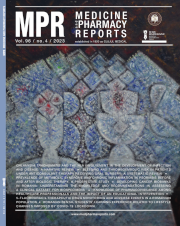5-fluorouracil therapeutic drug monitoring and adverse events in a Romanian population
DOI:
https://doi.org/10.15386/mpr-2643Keywords:
fluoropyrimidine, therapeutic drug monitoring, adverse eventsAbstract
Fluoropyrimidines represent the backbone of many chemotherapy protocols and the standard treatment for many types of tumors. Toxicity associated with fluoropyrimidines can occur in up to 40% of cases.
Background and purpose. The objective of this study was to analyze the correlation between the plasma concentration of 5-fluorouracil and the adverse events that patients might experience during this therapy.
Methods. A total of 58 patients received 5-fluorouracil-based chemotherapy. A blood sample was collected from each patient during the drug infusion, in order to assess the area under the curve for 5-fluorouracil. The occurring adverse events were evaluated through medical recordings of the patients’ reported symptoms, clinical and paraclinical examinations.
Results. In our study, the majority of patients experienced some type of toxicity. Moreover, we found a correlation between 5-FU plasma concentration (expressed as AUC) and adverse events, a stronger one with hematological adverse reactions and a weaker one with gastrointestinal and cardiovascular toxicity.
Conclusion. Determining the plasma concentration of 5-FU in patients with severe toxicities could represent a method of individualizing the treatment and improving the safety profile.
Downloads
Published
How to Cite
Issue
Section
License
The authors are required to transfer the copyright of the published paper to the journal. This is done by agreeing to sign the Copyright Assignment Form. Whenever the case, authors are also required to send permissions to reproduce material (such as illustrations) from the copyright holder.

The papers published in the journal are licensed under a Creative Commons Attribution-NonCommercial-NoDerivatives 4.0 International License.

